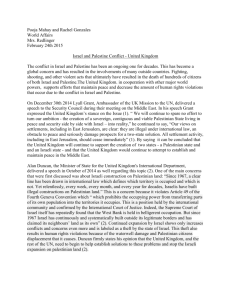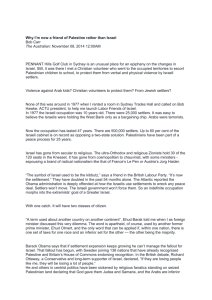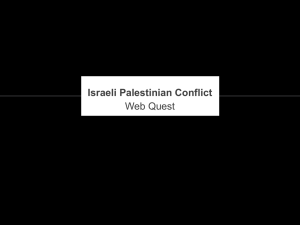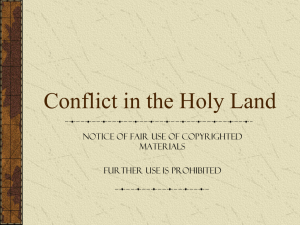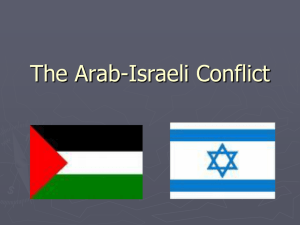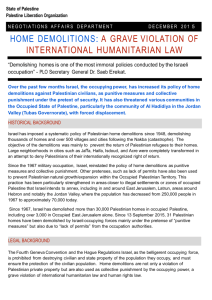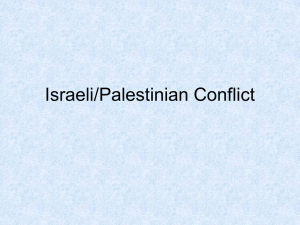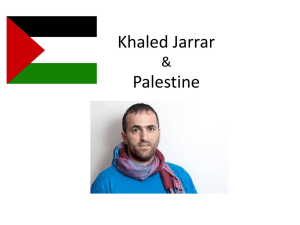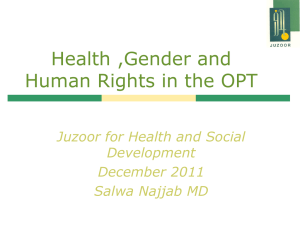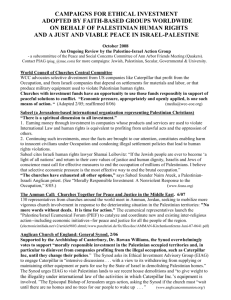View/Open - AUC DAR Home
advertisement
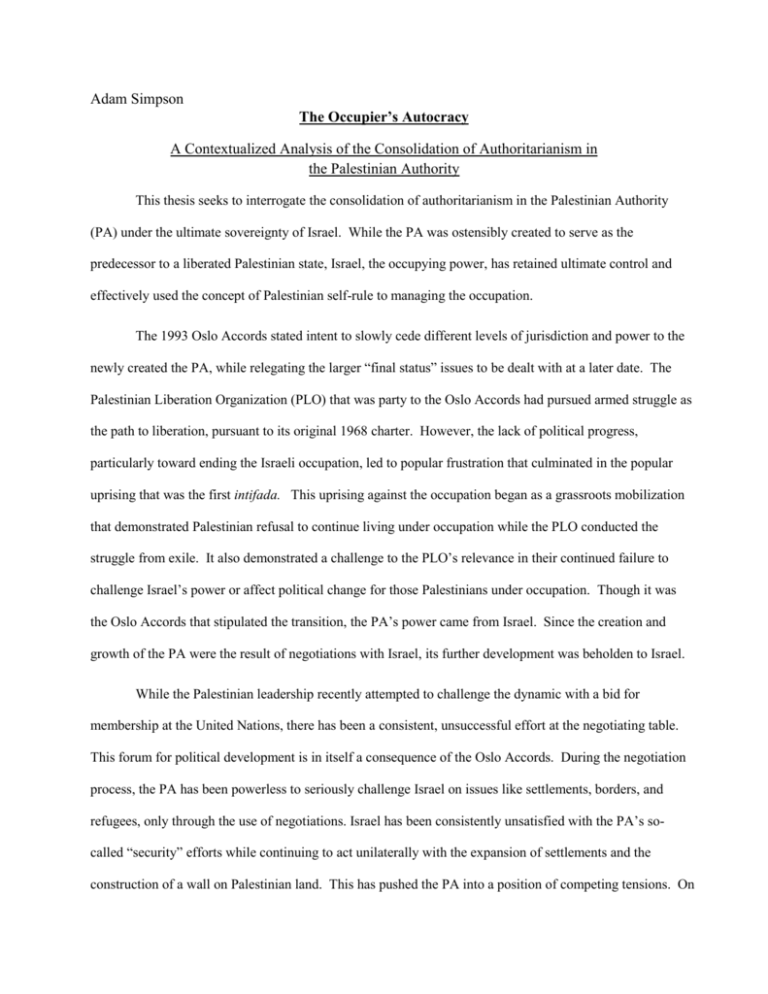
Adam Simpson The Occupier’s Autocracy A Contextualized Analysis of the Consolidation of Authoritarianism in the Palestinian Authority This thesis seeks to interrogate the consolidation of authoritarianism in the Palestinian Authority (PA) under the ultimate sovereignty of Israel. While the PA was ostensibly created to serve as the predecessor to a liberated Palestinian state, Israel, the occupying power, has retained ultimate control and effectively used the concept of Palestinian self-rule to managing the occupation. The 1993 Oslo Accords stated intent to slowly cede different levels of jurisdiction and power to the newly created the PA, while relegating the larger “final status” issues to be dealt with at a later date. The Palestinian Liberation Organization (PLO) that was party to the Oslo Accords had pursued armed struggle as the path to liberation, pursuant to its original 1968 charter. However, the lack of political progress, particularly toward ending the Israeli occupation, led to popular frustration that culminated in the popular uprising that was the first intifada. This uprising against the occupation began as a grassroots mobilization that demonstrated Palestinian refusal to continue living under occupation while the PLO conducted the struggle from exile. It also demonstrated a challenge to the PLO’s relevance in their continued failure to challenge Israel’s power or affect political change for those Palestinians under occupation. Though it was the Oslo Accords that stipulated the transition, the PA’s power came from Israel. Since the creation and growth of the PA were the result of negotiations with Israel, its further development was beholden to Israel. While the Palestinian leadership recently attempted to challenge the dynamic with a bid for membership at the United Nations, there has been a consistent, unsuccessful effort at the negotiating table. This forum for political development is in itself a consequence of the Oslo Accords. During the negotiation process, the PA has been powerless to seriously challenge Israel on issues like settlements, borders, and refugees, only through the use of negotiations. Israel has been consistently unsatisfied with the PA’s socalled “security” efforts while continuing to act unilaterally with the expansion of settlements and the construction of a wall on Palestinian land. This has pushed the PA into a position of competing tensions. On the one hand there has been the issue of human rights and the calls for democracy in the region. On the other hand Oslo mandated the PA to police the Palestinians in the West Bank and Gaza in a way that limits efforts and calls for armed struggle against the Israeli occupation. This policing became essentially a gear in the greater machine of Israel’s occupation. My thesis will emphasize that Israeli-Palestinian Authority relations can be analyzed on a far more frequent basis than merely at the negotiation table. Considering the infamous inefficacy of the peace process, I argue that the more regular, public dialogue is more relevant. I will analyze the Oslo agreements to set up a sort of formal structure that the Israeli government and the PA operate under, building on Neve Gordon’s conception of Israel’s “outsourcing” of the occupation. Afterward, I will detail the events on the ground that occur between the signing of the Gaza-Jericho Agreement in 1994 and the Interim Agreement in 1995 and analyze how the latter agreement was informed by the order imposed by the Oslo process. I will provide a similar analysis of events that occur between the Interim Agreement and the Wye River Memorandum. Scrutinizing the development of the Oslo process in the context of the public statements and public actions of the Palestinian and Israeli polities will allow for a unique analysis of this time period. This analysis will offer, unlike Gordon’s almost purely textual approach, an interrogation of the informal and far more regular system of discourse than the negotiated agreements. In short my main concern is not just to explain the relationship between Israel and the PA. Gordon’s concept of subcontracted power does this effectively enough. This thesis seeks to detail the process of how this consolidation of PA authoritarianism occurred by contextualizing its development as it relates to both the Oslo documents and that events occurring in real-time that either informed or failed to inform the socalled “peace process.” Works Cited Broenig, Michael. The Politics of Change in Palestine. 2011. Print. Chomsky, Noam. The Fateful Triangle: the United States, Israel, and the Palestinians. Boston, MA: South End, 1983. Print. Gordon, Neve. Israel's Occupation. Berkeley: University of California, 2008. Print. Kimmerling, Baruch. Politicide: Ariel Sharon's Wars against the Palestinians. London: VERSO, 2003. Print. Massad, Joseph Andoni. The Persistence of the Palestinian Question. London: Routledge, 2006. Print. Parker, Christopher. Resignation or Revolt?: Socio-political Development and the Challenges of Peace in Palestine. London: I.B. Tauris, 1999. Print. Parsons, Nigel. The Politics of the Palestinian Authority : from Oslo to Al-Aqsa. New York: Routledge, 2005. Print. Reinhart, Tanya. Israel/Palestine: How to End the War of 1948. New York: Seven Stories, 2002. Print. Reinhart, Tanya. The Road Map to Nowhere: Israel/Palestine since 2003. London: Verso, 2006. Print. Rubenberg, Cheryl. The Palestinians: in Search of a Just Peace. Boulder, CO: Lynne Rienner, 2003. Print. Said, Edward W., and David Barsamian. Culture and Resistance: Conversations with Edward W. Said. Cambridge, MA: South End, 2003. Print. Simpson, Gerald. Detainees Denied Justice. The Hague: Kluwer Law International, 2001. Print. Usher, Graham. Dispatches from Palestine: the Rise and Fall of the Oslo Peace Process. London: Pluto, 1999. Print. Weizman, Eyal. Hollow Land: Israel's Architecture of Occupation. London: Verso, 2007. Print.
